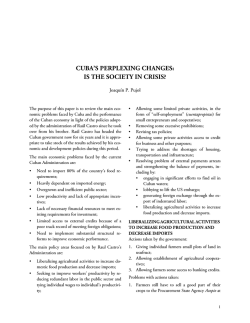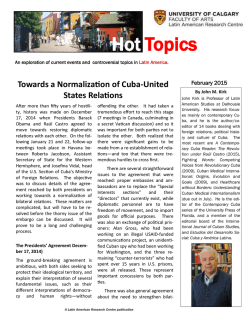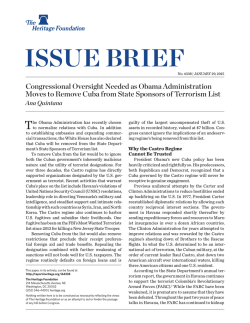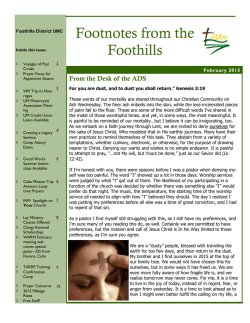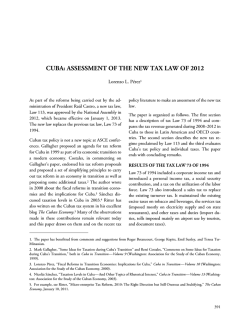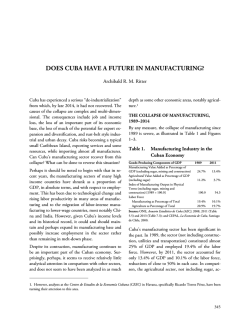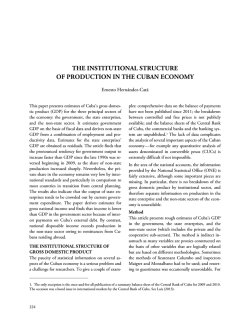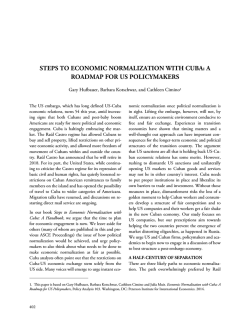
human capital and foreign investment
CUBA’S GROWTH STRATEGY: HUMAN CAPITAL AND FOREIGN INVESTMENT Luis R. Luis1 Cuba’s economic policy is firmly based on ideological grounds. Consequently it is not wholly appropriate to evaluate its current reforms and growth strategy in the usual terms for transition economies that emphasize efficiency, the role of markets and ownership rights (European Bank for Reconstruction and Development, 2013). Nonetheless, taking into account the ideological context and the seeming inability to instill deep market-oriented reforms, it is still useful to gauge prospects against the government’s own goals. EVALUATING THE GOVERNMENT’S STRATEGY The approach to evaluating the government’s growth strategy starts by ruling out two possible favorable events which an analyst cannot safely take as given. These favorable events would be: (1) a swift normalization of relations with the U.S.; and (2) the discovery and rapid exploitation of sizable oil fields. At the same time I also leave out possible events or shocks that could derail the growth strategy, for instance the swift cessation of concessional oil supplies and other business arrangements with Venezuela or a cata- strophic weather event. Such events are not unlikely and will be dealt with in a following section. It is clear from actions and statements by the government that the new approach to growth and development features two factors, the improved use of human capital and a new opening to foreign investment. A better use of labor and associated human capital is at the heart of the shift of employment from the state sector to the private sector. As of 2013 the share of output of the non-cooperative private sector was about 24% of GDP.2 The other key mechanism to improve utilization of Cuba’s considerable endowment of human capital is by way of the export of services of health and other professionals. Such non-tourism services exports have boomed from 3.2% of GDP in 2000 to 14.3% in 2012 according to official Cuban data (ONE, 2013 and previous issues). The second factor in the new strategy is an opening to foreign investment. Data on fixed capital formation and capital goods imports suggest an upper limit of around 1% of GDP for foreign direct investment in 2012 (Luis, 2014). This is well below the 4.3% average of 19 Latin American countries and partly ex- 1. This study benefitted from incisive comments from Ernesto Hernández-Catá. 2. This estimate for private sector output draws on private sector GDP estimates by Hernández-Catá (2014a), adjusted by subtracting estimated output from CCS cooperatives and adding output from investments by foreign private corporations. CCS cooperatives or Cooperativas de Crédito y Servicios encompass farmers who own farmland and associate themselves in a cooperative to obtain services such as distribution, farming services and credit. While these cooperatives have elements of free enterprise, they are tightly linked to state marketing and agricultural agencies. Going forward the expansion of CCS will also entail leasing land from the state which may reduce operational independence. As a general reference please see Nova (2011). 238 Cuba’s Growth Strategy: Human Capital and Foreign Investment plains the low investment level in the island. As a result the government is taking new measures, including the approval of a new foreign investment law on March 29, 2014. The Vice-President of the Council of Ministers, Marino Murillo, indicated that Cuba needs between US$2 and US$2.5 billion annually to meet development plans.3 Murillo stated that in the last decade, the overall investment ratio has been 13% of GDP. In fact, gross capital formation was 8.6% of GDP according to the 2012 national income accounts. Murillo also indicated that the economy needs output expansion of between 5% and 7% per year. THE MODEL In order to explore if such goals are plausible I engage in a simulation exercise with a model of the Cuban economy which incorporates physical and human capital, labor and foreign investment in the state and private sectors. The model is an extension of well known approaches to the theory and empirics of growth by Lucas (1988) and Mankiw, Romer and Weil (1992). The derived simulations are not forecasts, just a rather mechanical check to find out if the goals of policy are consistent with the broad parameters of the economy and prospects and assumptions regarding services exports and foreign investment. The model utilized here is based on production functions augmented with a variable for human capital and an efficiency mechanism lowering disguised employment in the state sector. The human capital variable enters indirectly into the production of nontourism services exports, where it may be paid closer to its marginal product than domestically, to the state if not to individual professionals. The main parameters of the model are derived wherever possible from national accounts and labor force data. The capital elasticity of output for the state sector of 0.6 is close to the average of seven estimated equations by Hernández-Catá (2014b) and matches the capital share of income in the national income accounts. The labor share of income is adjusted for income from non-tourism service exports. Foreign direct in- vestment is incorporated as capital flowing to the private sector. A policy variable has to do with the shift of labor from the state to the private sector but I only assume a modest shift per year of 5% of underutilized labor out of the state sector and into the noncooperative private sector. The model consists of the following equations: Xt=AKtα(Lt-Wt)λMt1-α-λ (1) X*t=AK*tβ(L*t-W*t)μM*t1-β-μ (2) ΔK= s(1- δ)Xt-1 (3) ΔK*=s(1- δ)X*t-1 + Ft-1 (4) ΔH = (1+g)(Lt-1 — ρWt-1) - Wt (5) ΔH* = (1+g)L*t-1 + ρWt-1 — W*t (6) ΔM = (1+π)Mt-1 (7) ΔM* = (1+π)M*t-1 (8) ΔL = (1+g)(Lt-1 — ρWt-1 ) (9) ΔL* = (1+g)L*t-1 + ρWt-1 (10) (10) Ft = γ(Xt-1 + X*t-1) (11) Ht Lt - Wt (12) In the model the * variables correspond to the private sector. Thus, Xt is state sector output in year t and X*t private sector. Augmented production functions determine sectorial output where Kt is capital, Lt labor available, Wt unutilized labor and Mt human capital of the Mankiw, Romer and Weil (1992) variety. Ht and H*t are effective labor used by the state and private sectors, respectively, entering directly into the production functions. The production functions are linear and homogeneous on parameters α, λ and β, μ. Other parameters are s, the savings rate, deemed to be equal for both sectors, g the overall rate of increase of the labor force, π the growth rate of non-tourism services exports, ρ the proportion of utilized labor in the state sector shifted to the private sector and δ the capital depreciation rate. Ft is foreign direct investment, a constant fraction of output γ, set by a policy target. Δ denotes a first difference. The system is simulated recursively with initial conditions matching 2013 sector shares of output consis- 3. “Cuba promueve inversión extranjera para desarrollar su modelo.” www.cubasi.cu/26790, March 2014. 239 Cuba in Transition • ASCE 2014 tent with production functions. The initial endowment of human capital is derived residually given labor, capital and output at the start of the simulation period. SIMULATION RESULTS The base case scenario in the simulation contains Vice President Murillo’s desired upper level for foreign investment. It also assumes ambitious growth of non-tourism services exports which expand at a 10% annual real rate. Foreign direct investment is assumed to be US$2.5 billion or 3.4% of 2012 GDP, a relative level maintained in the 10-year simulation. The savings rate is 12% and is considered entirely converted into physical capital in both sectors. Under these assumptions yearly output growth averages nearly 6%, with the private sector output expanding at a bit over 10% per annum. This is because foreign direct investment flows wholly into the private sector as well as the continuing shift of employment from the state to the private sector. At the end of the simulation period of 10 years the share of the private sector would be 36% of output as against 24% in 2013 Table 1. Simulation Results (% annual growth and share of output on year 10) Output State Growth Sector 1 Base-Savings 12%, Xnts 10%, FDI 3.4% 5.8 4.0 Private Output/ Private Sector Worker Share 10.2 5.3 35.7 2 Savings 8.6% 4.5 2.4 9.5 4.0 37.8 3 Xnts 5% 5.4 3.4 10.2 4.9 37.0 4 FDI 2% 5 Combination of 2, 3 and 4 5.5 4.0 9.3 5.0 33.8 3.8 1.9 8.5 3.3 36.7 Note: Savings is gross domestic savings as a % of GDP, Xnts is annual real growth of non-tourist services exports, FDI is annual foreign direct investment as a % of GDP. Savings is assumed to equal gross domestic investment. Simulation based on model by the author. What if savings and investment are equal to the 2012 investment level of 8.6% of GDP? A failure to lift the savings and investment rates would mean that output growth would be below the 5% minimum level outlined by Mr. Murillo, while state sector growth would nearly halve (Simulation 2). Is Cuba able to raise exports of services at a high rate? There are signs that the export of health professionals is beginning to strain medical services in Cuba. For example the number of health workers in Cuba declined by 76 thousand, to 490 thousand, between 2008 and 2012.4 In Simulation 3 the model is run with such services expanding at 5% per year rather than 10%. The impact on growth is not severe — about half a percentage point cut. Likewise a decline in foreign direct investment from 3.4% of GDP to 2% does not have a very large impact on output growth but will reduce the output share of the private sector by 3 percentage points (Simulation 4). Simulation 5, which combines the assumptions in the previous three simulations, is more likely than the base case. It shows a sizable impact, slashing yearly output and productivity (output/worker) growth by two percentage points from the base scenario. In this case official goals are clearly not met. The state sector expands by less than 2%. These calculations point out to the difficulty of reaching the objectives of the government’s growth strategy and the crucial role of domestic savings. Services exports and foreign investment have a substantial impact on long-term growth but as may be expected remain secondary to domestic savings. The mechanical approach of the calculations overlooks obstacles at the firm level because of the lack of working market mechanisms to improve resource allocation, which suggest the need for a more vigorous approach to price liberalization. Ongoing reforms involving some price liberalization and the future unification of exchange rates imply some increase in efficiency and improvements in resource allocation. The model nonetheless implies efficient investment mechanisms. It allows for inefficiencies by means of underutilized labor, expressed as the parameter ρ in equations (5) and (6), in the state and private sectors. 4. Cuadro 94. Trabajadores de la Salud. 1976–2012. República de Cuba, Ministerio de Salud Publica, Anuario Estadístico de Salud 2012. 240 Cuba’s Growth Strategy: Human Capital and Foreign Investment In the base case the simulation assumes a savings rate that is 3.5 percentage points over current levels but that is still quite low for the standards of transition economies or emerging countries. The government could be more ambitious regarding foreign investment than it is now signaling. Success in attracting foreign investment has to do much less with the new law than with the creation of a positive business environment, a secure level playing field for foreign corporations and the enforceability of contracts. Success in attracting even the moderate investment flows Mr. Murillo outlined would nonetheless change the complexion of the economy and bring about a more important role for the private sector and positive externalities which are not modeled. At the end will economics trump ideology? SIMULATION WITH A SHARP EXTERNAL SHOCK What could derail Cuba’s development and growth strategy? Aside from deep political change, this could arise from a sharp external shock to the economy. A well-defined event that many analysts and commentators have in mind is the falling apart of the tight relationship between Cuba and Venezuela, which is broadly compared to the alliance between Cuba and the Soviet Union during 1961–1990. The precise elements, timing and scope of a breakdown in the Cuba-Venezuela relationship are of course unknowable. In this section I simulate the case of an extreme event where there is a sharp sudden breakdown of the relationship leading to the departure of Cuban health, administrative, security and other personnel from Venezuela and the end of concessional oil terms for Havana. Some analysts in Venezuela and elsewhere think such a drastic outcome is unrealistic no matter the political evolution in Caracas, with or without the ruling PSUV (Partido Socialista Unido de Venezuela) party in power. It is very useful nonetheless to study a sharp shock to gauge the resilience of the economy and gain insights into the implications for the growth strategy. The Venezuelan shock has two elements: first, and most important, the cut of Venezuelan imports of Cuban health, administrative and other services; and second, a higher relative price of oil imports in terms of Cuban resources plus a technological impact because of the temporary inability to use a segment of Cuba’s capital stock, for example oil refineries geared to process Venezuelan crude. The shock simulated here involves a cut of 80% in Cuba’s non-tourist services exports or roughly an amount equivalent to the level of such services provided to Venezuela.5 This shows as a sudden displacement of human capital in the model. In addition a smaller shock which would be transmitted by the higher price (in terms of real exports) Cuba would have to pay for oil imports from Venezuela or elsewhere as well as a technological impact from temporary dislocation of refinery and other Venezuela related output. This in turn is expressed in the model as a 5% slackening of utilization of the capital stock. The simulation also takes into account some adjustment by means of a 10% per year continuing increase in non-tourism services exports elsewhere though these would take place at a discount to Venezuelan terms. This takes for granted that Cuban doctors sent to Venezuela are of the same qualification and experience required in other countries, while it is doubtful that Cuban security services will readily find a market elsewhere. Since the simulation uses a pure growth model I do not incorporate financial assets that could be used to cushion external shocks as discussed in Luis (2012). These external assets have dwindled since 2012 reflecting diminished financial flows from Venezuela arising from economic problems there. The sharp shock leads to a depression in economic activity. Output falls by 7.6% on the year after the shock. As the direct links with Venezuela involve almost exclusively the state sector, its production falls by 14.5%. Average worker productivity in the state 5. This number is a rough estimate obtained by working down from the figure for exports of goods and services in the national accounts and subtracting merchandise and tourism exports and an estimate for health services exports from official statements. There remains a sizable residual of non-tourism, non-health services which apparently relate to other services Cuba provides Venezuela. 241 Cuba in Transition • ASCE 2014 Figure 1. Sharp Venezuela Shock sector falls a whopping 13.7%. There are effects on private sector output through the higher cost of energy. It helps that foreign investment continues to shield private activity, and output continues to expand. The shock reduces overall output of the economy to an average of 4% for the 10 year simulation period, a nearly 2% annual drop from the base case, with only 1.3% growth for the state sector. This is expected as the state sector is closely tied to Venezuela through the exports of services and oil imports. While the model considers an oil price impact on the private sector it does not show income effects arising out of the sharp shrinkage of the state sector. This means the estimates obtained here underestimate the impact of the shock. Table 2. Venezuela Shock: Base and More Likely Cases (% impact/GDP and annual growth) Shock under Base Case Shock under More Likely Case Output Output Impact Growth State Sector -7.6 4.0 1.3 10.0 3.5 -9.5 2.3 –0.1 8.3 1.7 Source: Simulation based on model by the author. 242 Private Output/ Sector Worker I also run a shock simulation under the more likely assumptions of lower savings, foreign investment and growth of services exports as explained in the previous section. Table 2 compares the results of the two shock simulations. In the second case output falls 9.5% or nearly 2% more than under the base case shock, and 16% in the state sector. Long-term output growth is 2.3% as against 4%, while the state sector stagnates and worker productivity advances just 1.7% The calculations from the model are of a similar order of magnitude as those reached by HernándezCatá (2013), but sharper than an estimate by Vidal (2014) using different models that reflect the historical structure of the economy. Hernández-Catá finds the impact at 7% to 10% of GDP from macroeconomic effects, mostly the decline in utilization of the capital stock, a range similar to the 7.6% to 9.5% estimated here. Vidal (2014) finds that GDP would fall 7.7% over a four year period upon the dissolution of the Cuban-Venezuelan alliance if it were to follow the same time pattern as the breakdown in relations between Cuba and the Soviet Union. To be sure the time-pattern of the decline in output will vary depending on diverging assumptions in these Cuba’s Growth Strategy: Human Capital and Foreign Investment models. The model used here, for example, assumes only a one-year disruption of the capital stock. An important consequence of the sharp Venezuelan shocks is the impact on the sectorial structure of output. At the end of a 10-year period the share of output of the private sector after the shock is about 42% while without shock it is 36% (Figure 1). This is a reflection of the wide impact a sharp Venezuelan shock would have on the Cuban economy and society. The stagnation of the state sector will lead to a deeper shift of labor out of the state sector or within the sector from state enterprises to cooperatives. One may speculate as to whether or not such a shock may lead to deeper market-oriented reforms. These prospects would naturally depend on changes in outlook of and constrains on the political leadership However, almost surely the economy would need to open up further to international trade and investment as a means to make-up losses from the breakup of the Caracas alliance. PRIVATE SECTOR AND MARKETS The private sector in Cuba is atomized by restrictions on activity and size of firms, price controls, relative price distortions, high taxes, poor access to finance, lack of wholesale markets, curtailed property rights and excessive regulation, among other factors. In spite of these factors and less important elements, market transactions are spreading and will show solid growth in coming years according to the simulations here, transforming the economy. The simulated growth paths denote a faster pace for private sector productivity compared to the state sector. In the base simulation, the preferred scenario of policymakers, there is a difference of 0.2% per year in output per worker growth between the private and state sectors (5.2% versus 5.0%). In the more likely scenario (Simulation 5) the difference is 0.6% (3.5% versus 2.9%). The simulations assume that the bulk of the projected reduction of workers from state enterprises and the central government6 will shift to cooperatives which in the model remain in the state sector. Given the prevalent view in the government that cooperatives have a broader social function than generating profits this does not bode well for their future performance. I discuss cooperatives in more detail in the next section. A key element energizing the private sector in the simulations is foreign investment, which I assume flows entirely into the private sector. In recent years an important component of direct investment has originated in foreign state-owned companies from Venezuela but also from China, Ecuador and Iran. While the government favors foreign state companies in joint ventures with Cuban state firms and cooperatives, this may not be suitable to develop Cuba’s comparative advantages. Chinese and other state owned firms abroad are heavily involved with natural resources and construction. They will undoubtedly have a role in oil exploration and production, mining, shipping and some infrastructure projects. Some of this will use long-term debt rather than equity financing. Manufacturing, technology and service investments will, on the other hand, be carried out largely by private corporations. The role of markets in Cuba is expanding. This mostly involves retail markets for foodstuffs from private farmers and small scale personal services such as restaurants, repair shops and street vendors. Yet much of private sector output is not priced in domestic markets, for example farming output sold to state marketing agencies and mining exports priced abroad. Nearly all state procurement takes place at non-market prices. According to official statistics 21.2% of household consumption in 2012 was undertaken in non-state markets, up 1.7% from 2007. Some of these transactions involve administered prices. This still is a small share of production and is a modest expansion from market coverage in five years. Determined price liberalization would have to involve the state sector. Large segments of the consumer economy including the provision of imported foodstuffs is controlled by state conglomerates with administered prices for both product and input markets. This is a roadblock to creating wholesale markets and efficient markets for consumer products. 6. Frank, Mark, “Cuba continues to trim state payroll, build private sector.” Reuters, Havana, February 24, 2014. 243 Cuba in Transition • ASCE 2014 There are no plans for widespread privatization in the island. Large scale privatization is out of the question. Small scale privatization is another matter. In this case the government is creating an environment where micro firms can operate, though with many limitations regarding size and employment, as cuentapropistas that at the end of 2013 reached 445,000 according to the labor ministry.7 Regarding medium and small state enterprises, the government and the communist party have decided to follow a route that does not involve privatization but destatization through transformation of state firms into cooperatives. COOPERATIVES — DO THEY HAVE A FUTURE? The government’s approach to restructuring small and medium-sized state companies, reducing state employment and firm subsidies involves cooperatives. Cooperatives are viewed as socially-oriented institutions that preserve employment and share management decisions among members.8 This is a way to induce change in the economy with restrained capitalism. So it is expected that the growth of cooperative employment and output will be high as the goal of reducing government and state enterprise employment by another 500,000 workers is implemented. As mentioned above, cooperatives in this paper are considered as part of the state sector. While cooperative members in many cases, such as CCS farm cooperatives, own land and other means of production, their activities are still conditioned to the supply of inputs, marketing and technical direction from state agencies and face legal restrains on hiring and wages that have been codified by existing and new cooperative legislation in 2012. This is changing territory and cooperatives could evolve into entities that operate freely following market principles. The new law of cooperatives provides for non-agricultural cooperatives that are democratic in principle, although subject to approval at the local and national levels. For cooperative income tax purposes, wages are account- ed as equal to the average for that occupational level at the province of residence. This means the cooperative will have to decide whether to have revenues taxed at the personal or cooperative tax rates and in either case earnings available for reinvestment would be limited. Cooperatives are not allowed to share profits among their members.9 The dynamics of cooperatives in Cuba are not easy to model. First, there are wide differences among them as to management quality, productivity and degree of involvement of state agencies. Second, capitalization of cooperatives is an open question. Retained surplus or earnings are a source of capital as long as the firm is reasonably profitable. Many if not most of the medium-sized state enterprises that will be converted to cooperatives do not appear to be very profitable. Many of the new cooperatives will then in effect be turnaround operations something hard to do under ideal circumstances much less in the current economic environment and the lack of management expertise. Banks and credit institutions can provide capital in the form of loans but not equity. Loans are flowing to new cooperatives converting from state firms although no overall statistics are available. Cooperatives could represent an improvement on state corporations in terms of job satisfaction and efficiency as work incentives improve and pilfering is reduced. The international experience is mixed in evaluating cooperatives versus traditional market-oriented firms. In Italy where there are large numbers of cooperatives side by side traditional firms, cooperatives provide more stability but lower wage levels, while in France the performance of cooperatives is comparable to that of traditional firms (Pencavel, Pistaferri and Schivardi, 2006) and (Fakhfah, Perotin and Gago, 2012). Could cooperatives represent an important source of growth? Gross national savings in Cuba averaged 11% in 2007–2010, the last data available. State enterprises likely contributed at least one-half of this 7. “Cuba cuenta con casi 445,000 cuentapropistas,” www.cubadebate.cu/noticias/2013/12/20. 8. See Piñeiro Harnecker (2011), Prólogo, pp. 7 – 31. 9. For an updated review of the evolving legal and tax regime for cooperatives see Ritter (2013). 244 Cuba’s Growth Strategy: Human Capital and Foreign Investment and a few large firms account for the bulk of earnings. So new cooperatives will start with scant funds and will need considerable financial support. More challenging will be raising coops profitability to make them agents of growth not only instruments of social policy. REMITTANCES HAVE AN INVESTMENT COMPONENT According to existing Cuban and U.S. government regulations, remittances are to be used for consumption. Naturally money is fungible and remittances often form part of the initial investment and working capital of many microenterprises. The new foreign investment law allows investments from Cubans abroad and this presumably applies to direct investment projects. In a way remittances are in effect a kind of portfolio investment in family or friend’s enterprises more akin to private equity than to traditional investments in equity or debt securities. Some remittances are in effect loans that can be used to capitalize a micro firm. Other remittances provide working capital in the form of inventory for retail establishments. The current investment component of remittances is not known but is likely to be large, rivaling or surpassing my guess estimate of 2012 foreign direct investment of around 1% of GDP. Some of this should begin to show up in the national income accounts as investment. Greater remittances would have a posi- tive effect on savings. The government nurtures remittances, recently by allowing much freer migration of workers while maintaining Cuban residence. There is no sign that the government is considering formalizing its investment component by allowing private firms to issue equity securities abroad. CONCLUSIONS According to simulations with a model of the economy developed by the author, the government’s longterm objectives are achievable under its own desired conditions regarding the savings rate, foreign investment and continuing high growth of services exports. Under less favorable but still improved conditions regarding foreign investment and services exports, the goals are not met and growth would be less than 4%. In all simulations, growth of the private sector would be brisk compared to the state sector boosted by foreign investment and additions to the labor force from state firms and government. A sharp Venezuelan shock would derail the growth path and lead to an economic depression with output falling as much as 9.5% and 16% in the state sector. Cooperatives are more agents of social than economic policy. Their growth dynamics appear to be weak but the jury is still out. Remittances impact domestic savings and investment by the provision of capital, loans and working capital and boost private sector development. REFERENCES European Bank for Reconstruction and Development, 2013, “Transition Indicators Methodology.” www.ebrd.com/pages/research. Fakhfakh, F., Perotin, V. and Gago, M., 2012, “Productivity, Capital, and Labor in Labor-Managed and Conventional Firms: An Investigation on French Data.” Industrial and Labor Relations Review, 65 (4). Hernández-Catá, Ernesto, 2013, “Cuba, the Soviet Union, and Venezuela: A Tale of Dependence and Shock.” Cuba in Transition — Volume 23, pp.195–204. Hernández-Catá, Ernesto, 2014a, “The Institutional Structure of Production in the Cuban Economy.” Cuba in Transition — Volume 24. Hernández-Catá, Ernesto, 2014b, “Accounting for the Growth of Real GDP in Cuba. An Exploratory Empirical Study” in Economic Behavior, Game Theory and Technology in Emerging Mar- 245 Cuba in Transition • ASCE 2014 kets. Brian Christiansen and Basilgam Muslum, editors. IGI editions (2014). Lucas, Robert E., 1988, “On the Mechanics of Economic Development.” Journal of Monetary Economics, 22(1):3–42. Luis, Luis R., 2011, “Economic Impact of New Employment, Tax and Financial Policies in Cuba,” Cuba in Transition — Volume 21. Luis, Luis R. 2012, “Cuba: External Cash Flow, Barter Trade and Potential Shocks,” Cuba in Transition — Volume 22. Luis, Luis R., 2014, “Foreign Investment in Cuba: Mariel and Liberalization.” www.ascecuba.org/ blog/post/2014/02/08 Mankiw, N. Gregory, Romer, David and Weil, David, 1992, “A Contribution to the Empirics of Economic Growth.” Quarterly Journal of Economics, 107(2): 407–37. 246 Nova, Armando (2011), “Las cooperativas agropecuarias en Cuba 1959–presente” in Piñeiro Harnecker, Camila (ed), 2011, pp. 221–236. Pencavel, J., Pistaferri, L. and Schivardi, F., 2006, “Wages, Employment, and Capital in Capitalist and Worker-Owned Firms/” Industrial and Labor Relations Review, 60 (1), 23–44. Piñeiro Harnecker, Camila (ed), 2011, Cooperativas y Socialismo: Una Mirada desde Cuba. Habana. Editorial Caminos. Ritter, Archibald, 2013, “Potentials and Pitfalls of Cuba’s Move Toward Non-Agricultural Cooperatives.” Cuba in Transition — Volume 23. Oficina Nacional de Estadísticas, 2013, Cuentas Nacionales 2012. Vidal, Pavel (2014), “Proyecciones macroeconómicas de una Cuba sin Venezuela.” Desde la Isla, Cuba Study Group, 20 de febrero de 2014.
© Copyright 2026
